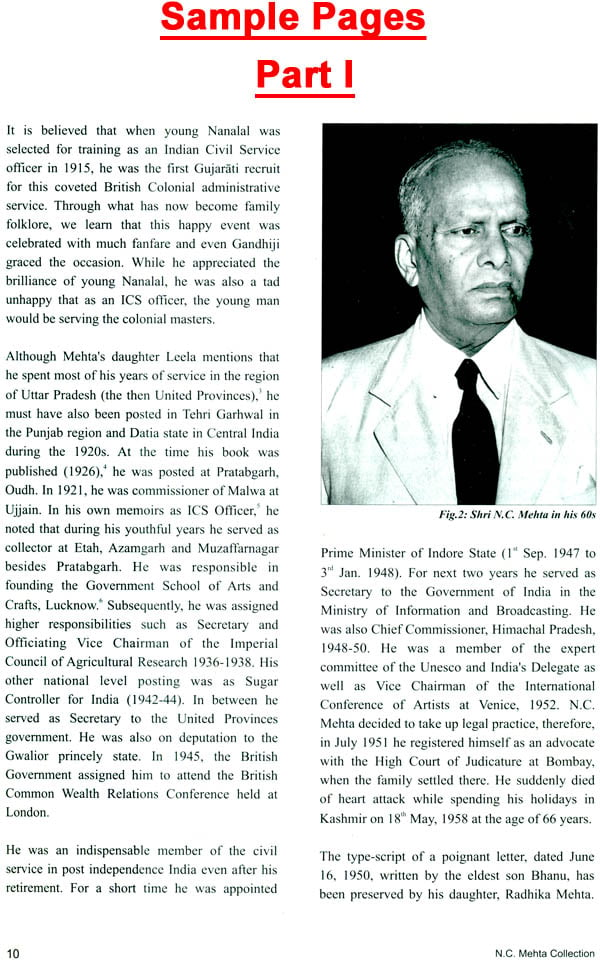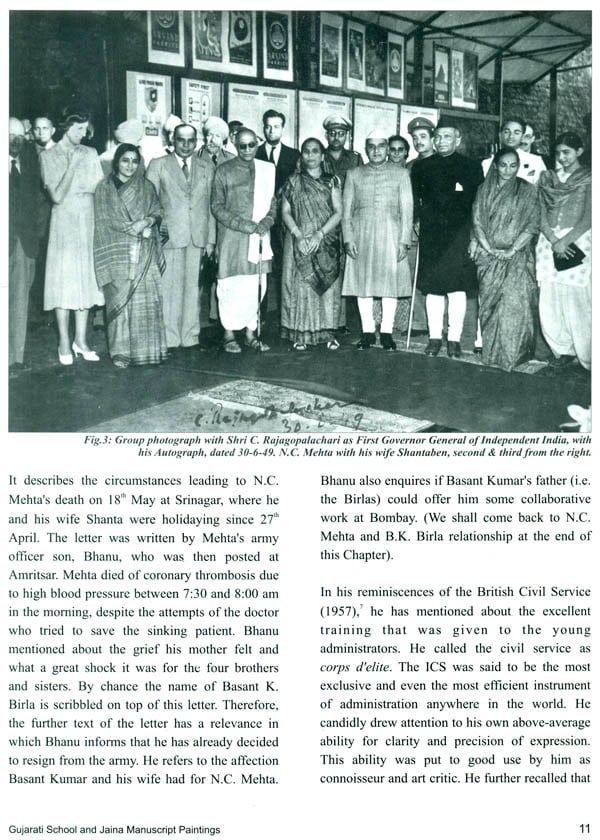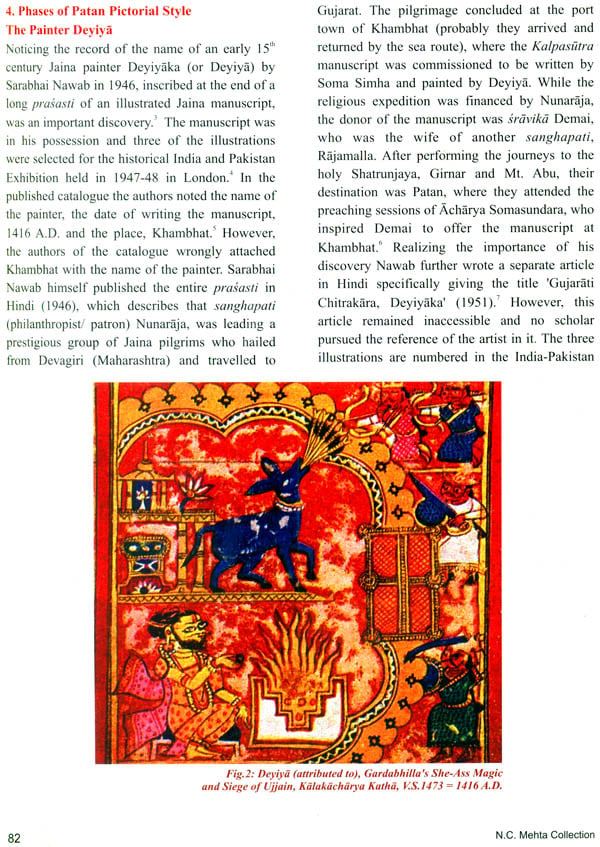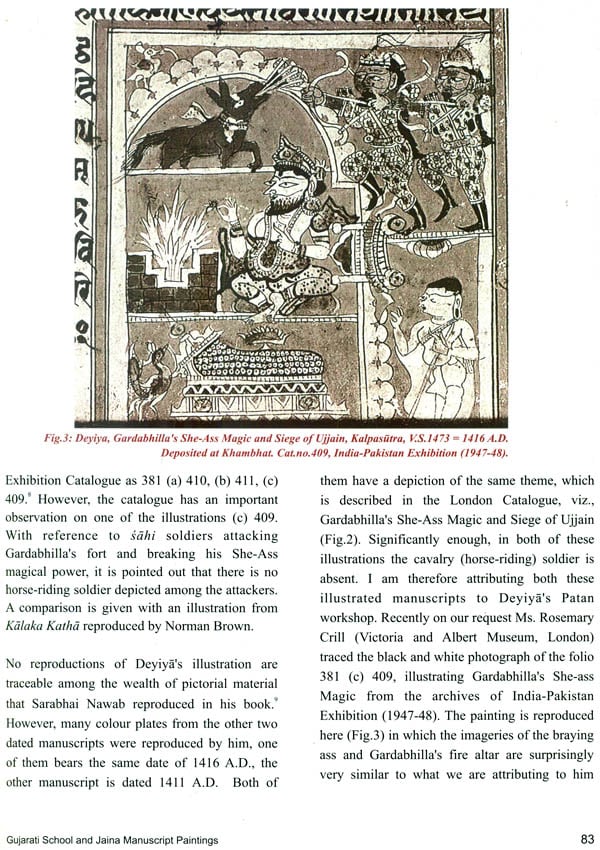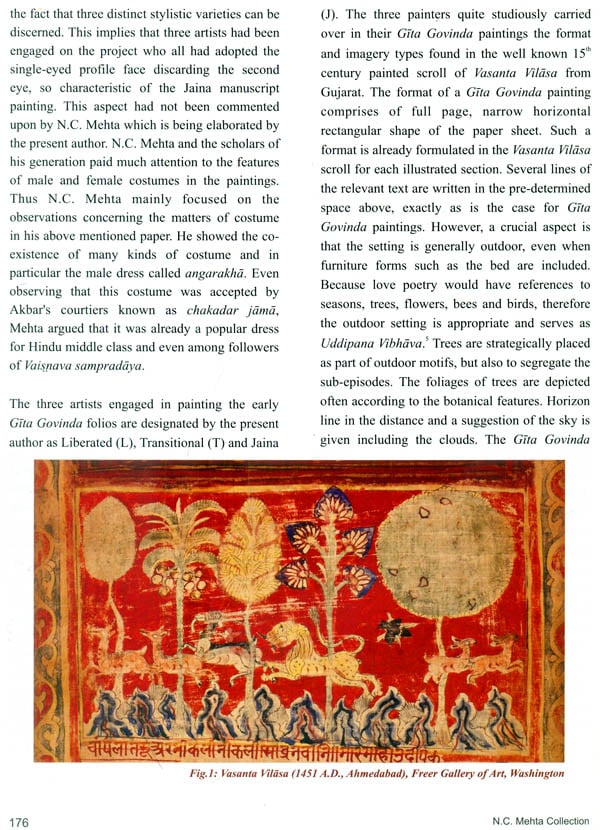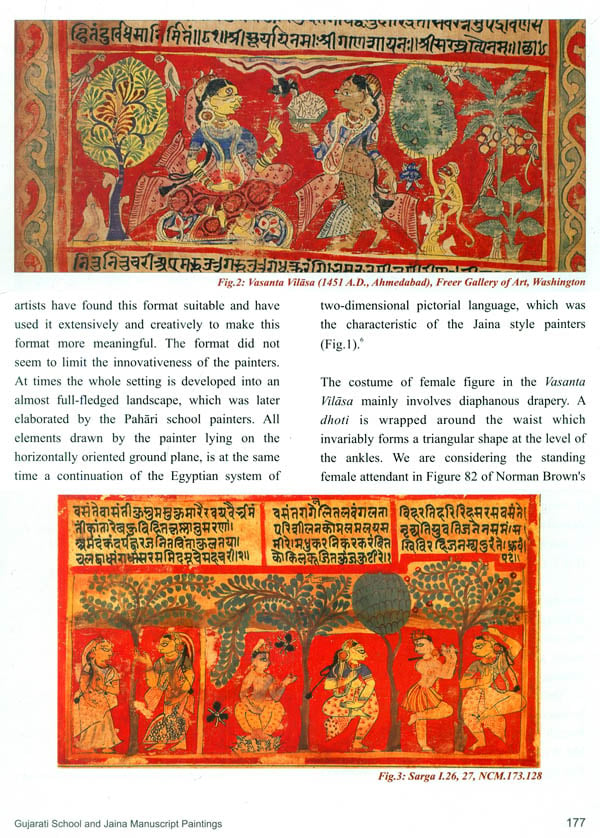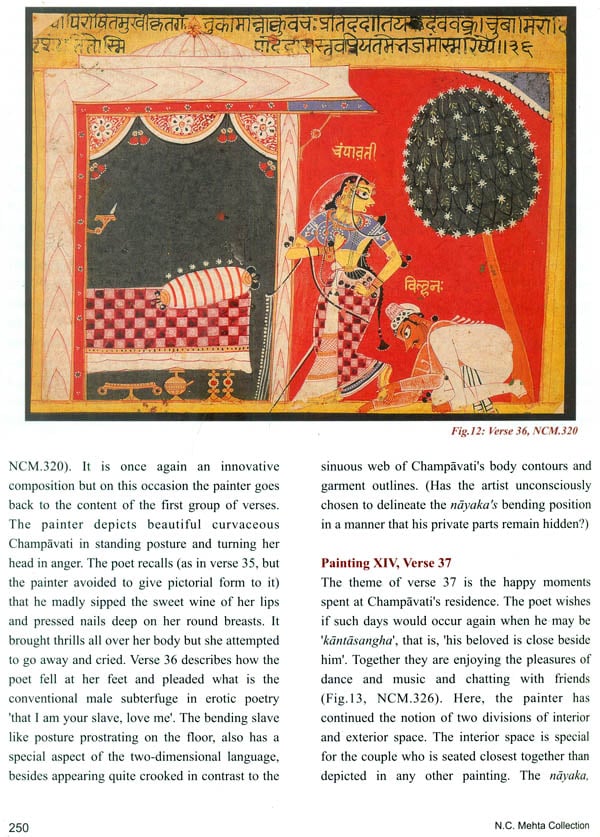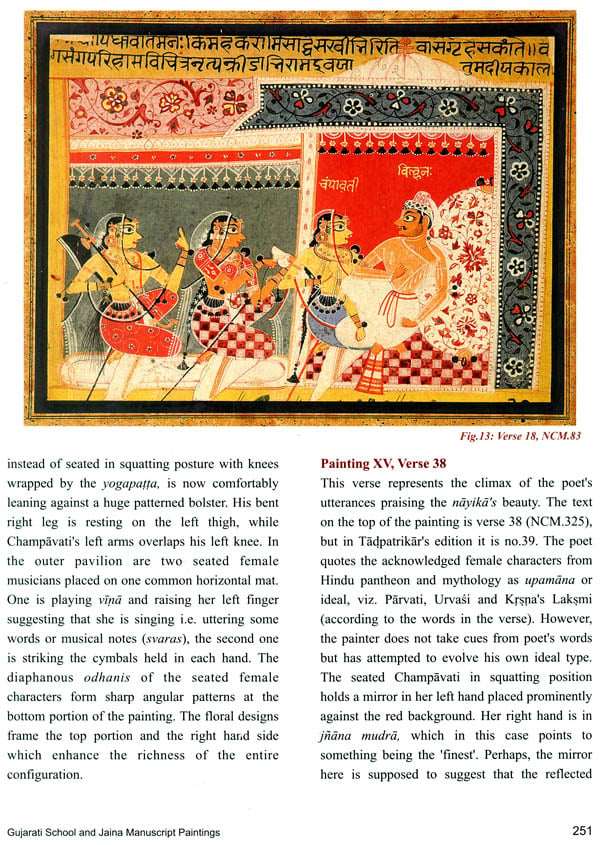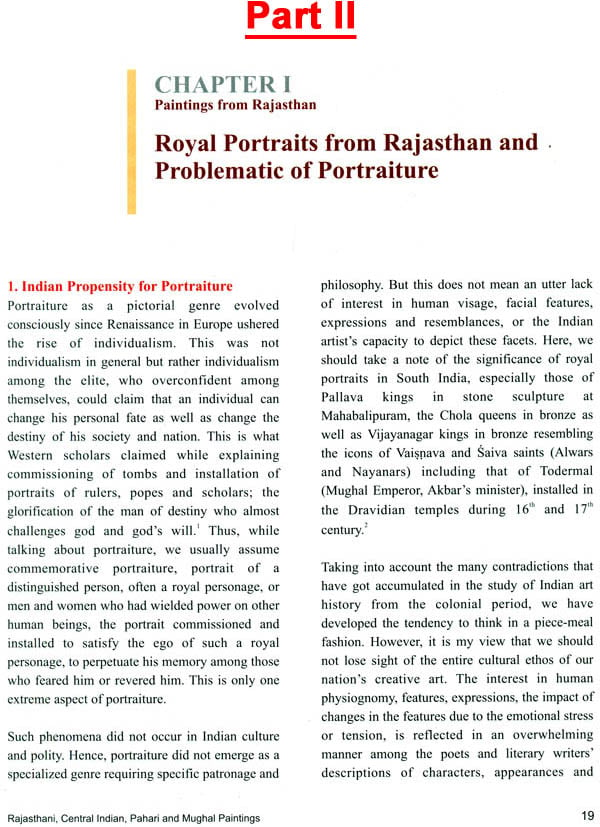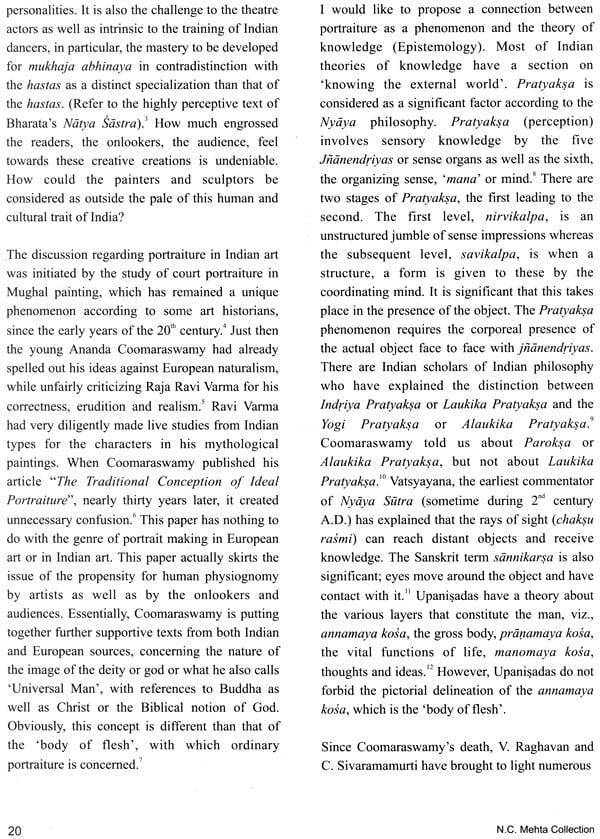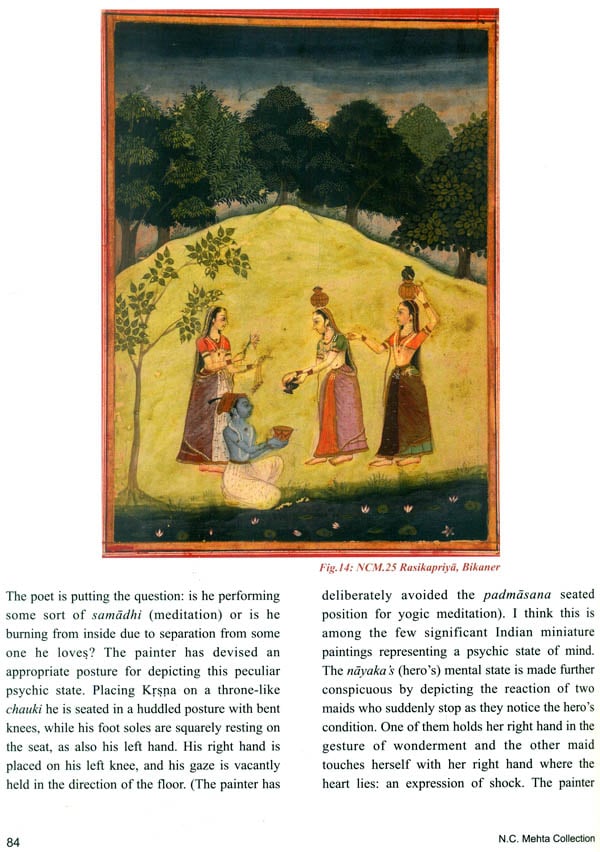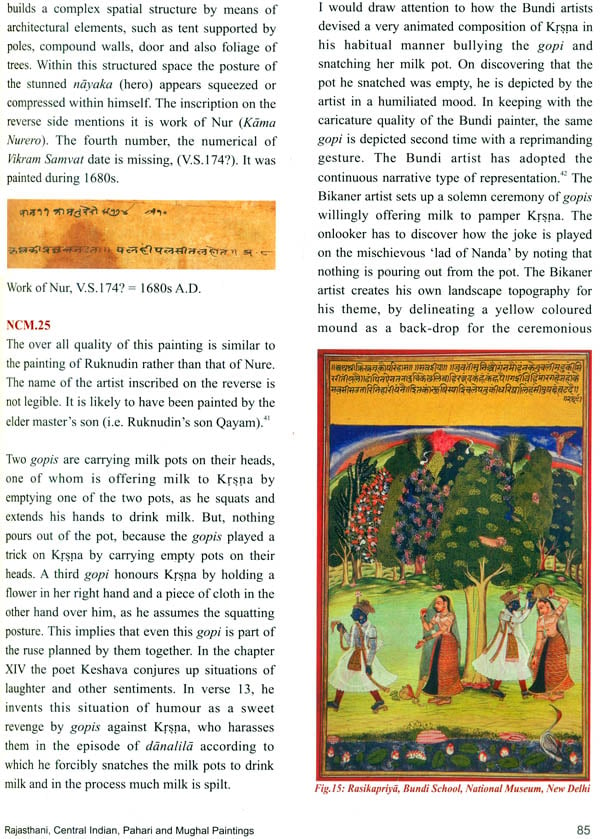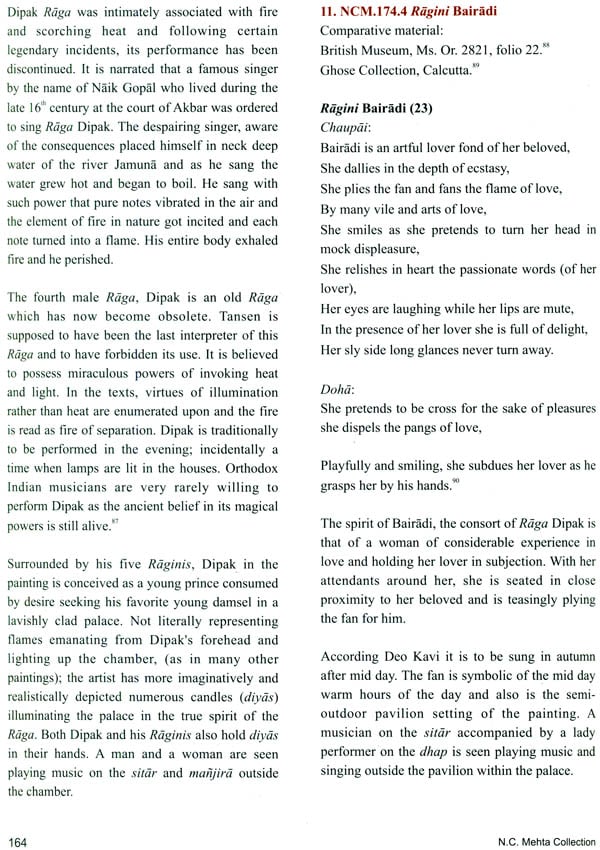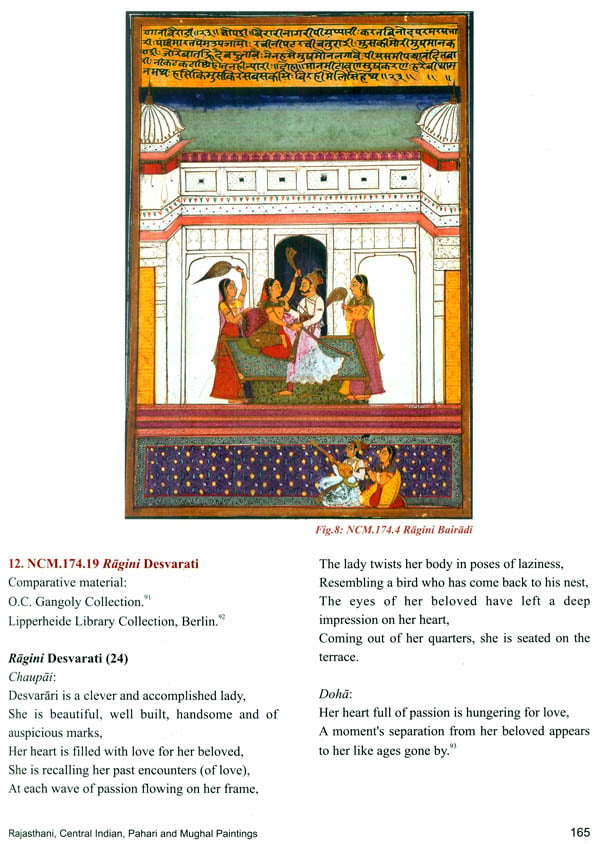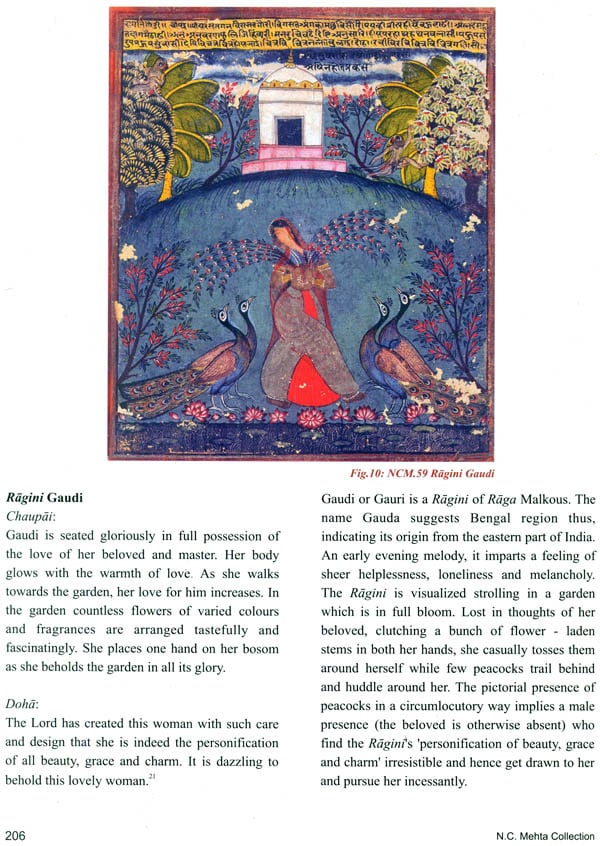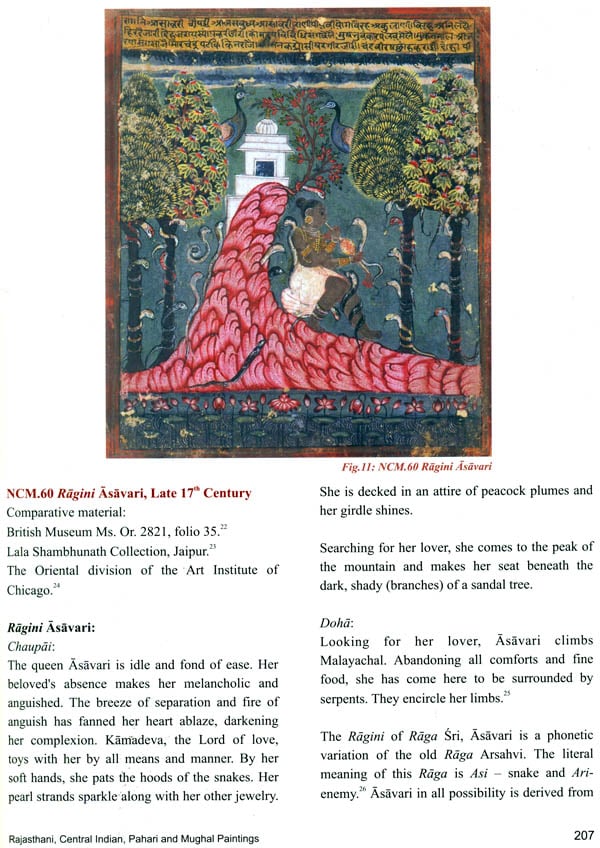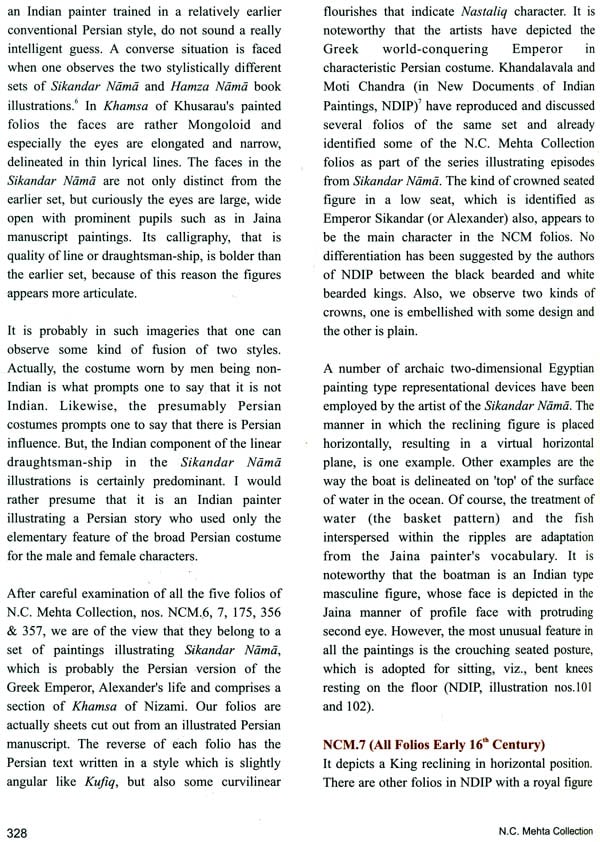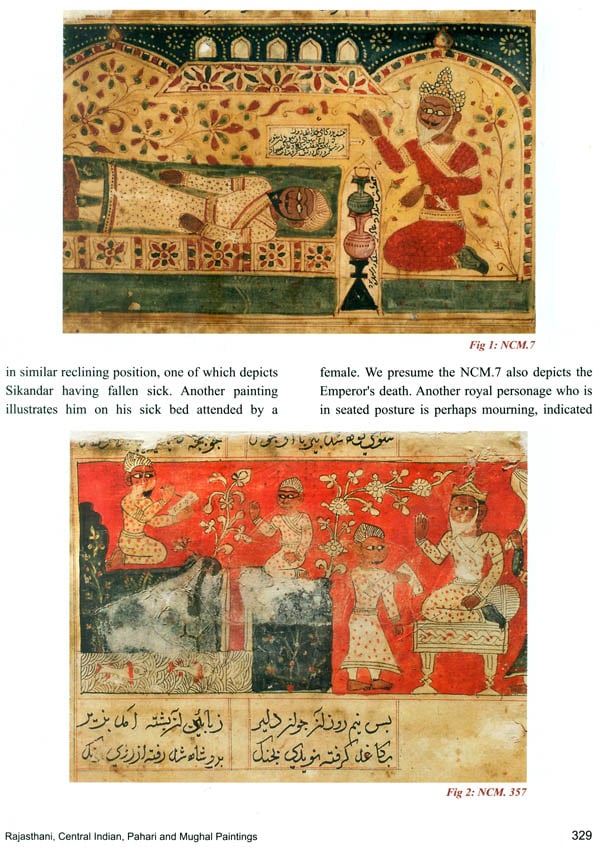
N. C. Mehta''s Collection of Paintings (Set of 2 Volumes)
Book Specification
| Item Code: | NAN292 |
| Publisher: | Gujarat Museum Society, Ahmedabad |
| Edition: | 2013 |
| ISBN: | Part I: 9788192044606 Part II: 9788192044613 |
| Pages: | 688 (Throughout Color & B/W Illustrations) |
| Other Details | 11.5 inch X 8.5 inch |
| Weight | 3.20 kg |
Book Description
The world famous collection of Indian miniature paintings assembled by Nanalal Chamanlal Mehta represents most of the schools and wide range of themes from 16th to 19th centuries. It is housed in the Lalbhai Dalpatbhai Museum in Ahmedabad since 1993. In the present Volume the author has covered illustrated Jaina Manuscript paintings which are published for the first time along with the early Gita Govinda illustrated folios. The Chaurapanchasika paintings based on the 11th century poet, Bilhana’s 50 verses, are the piece de resistance. It is the contention of the author that all these exquisite sets of paintings were painted in Gujarat, therefore, they represent the Gujarati School of painting. Hence, the title of the book is ‘Gujarati School and Jaina Manuscript Paintings’. The present author has propounded the theory that the so called Western Indian style of Jaina paintings was essentially the contribution of Gujarat with epicentre at Patan. To support this view point the author has put together elaborate documentation concerning the extensive manuscript writing patronized by the inspiring Jaina acharyas and the munificent businessmen community. Significantly the names of a few painters have also been discovered. A whole chapter is devoted to the Kalpasutra paintings which include Panchakalyanakas, five essential episodes of Tirthankara, followed by chapters on Kalaka Katha and Sangrahani Sutra illustrations. The author has analyzed how the paintings of Vaisanava themes and Srngara subject matter have emerged out of the Jaina style of Gujarat. The profusely illustrated early Gita Govinda is extensively published for the first time which establishes that the Gujarati artists initiated the pictorialization of poetic themes of divine and human love culminating with the most creative Chaurapanchasika paintings. Their poetic content has been quite eloquently interpreted by the author. In conclusion the author points out the unique nature of the language of Indian pictorial art and how Gujarati artists immensely contributed towards giving it a character. The highly respected eminent art historian, Smt. Kapila Vatsyayan, has written an appreciative Foreword endorsing many of the author’s ideas and methodology.
Prof. Ratan Parimoo has been Head of the Department of Art History & Aesthetics for 25 years (1966 - 1991) at the Maharaja Sayajirao University of Baroda. He was appointed Professor in 1978 and has also served as Dean of the Faculty of Fine Arts at the same University for 6 years (1975 - 1981), He began his teaching career in Art History & Aesthetics in 1959. Besides being a leading art historian, He was awarded the Jawaharlal Nehru Fellowship (1991 - 1993), he is also an eminent painter. Another significant aspect of his personality is that he is equally at home with both contemporary as well as traditional arts of India in his critical writings. As a life led as painter, art historian and art teacher, he has been interested in interdisciplinary study of the arts, which is reflected in the encyclopedic critical anthology edited by him entitled, ‘Creative Arts in Modem India’.
As a commonwealth scholar, Prof. Parimoo went to London University to study History of European Art at the Courtauld Institute of Art. He received the Rockefeller Grant to travel in the U.S.A., where he studied Indian Sculpture briefly under the great art historian, the late Dr. Stella Kramrisch. He was invited to participate in the twenty-third World Congress of the International Society of Education through Art, held in Australia. He is the chief editor of the prestigious collection of papers read on the occasions of the seminars organized in his department at Baroda, viz. (i) UGC workshop on History of Art, (ii) Vaishnavism in Indian Art & Culture, (iii) Ellora Caves: Sculptures & Architecture, and (iv) the Art of Ajanta: New Perspectives. His individual publications include, (a) Paintings of the Three Tagores: Abanindranath, Gaganendranath and Rabindranath, (b) Studies in Modem Indian Art, (c) Sculptures of Sheshasayi Vishnu, (d) Life of Buddha in Indian Sculpture, and (e) Essays on New Art History Studies in Indian Sculpture. He has written extensively on the subject of Jatakas in Buddhist Art emphasizing on narratology in the Indian pictorial arts. He also continues to write on modem Indian Art. In 2009 he edited ‘Historical Development of Contemporary Indian Art 1880 - 1947’, published by Lalit Kala Akademi, New Delhi. He is currently the Director of L.D. Museum & N.C. Mehta Gallery, Ahmedabad.
Ratan Parimoo has undertaken a Himalayan task of cataloguing the N.C. Mehta Collection of miniature paintings. His two volumes are not a catalogue in the conventional sense. The undertaking is much more, both in approach as also presentation. Cumulatively it is a comprehensive critique of the historiography of the discourse on evaluating the entire field of miniature painting, roughly grouped together under varied appellations and nomenclatures, such as Western Indian! Gujarati, Jaina, Chaurapanchasika, Malwa, Mewar extended to other Rajasthani Schools and the Mughal School. (Pahari paintings grouped under diverse styles, e.g. Basholi, Kangra, Guler, Nurpur, etc. were, published earlier by Karl Khandalavala). This is indeed a heroic task requiring assiduous, painstaking perusal of a vast body of dispersed material while never digressing from the principal task of perusing, cataloguing and assessing N.C. Mehta’s unique collection comprising paintings from all the schools mentioned above as examples.
He has divided his work into six sections, through eighteen chapters and three appendices - one contributed by Manjulal Majmudar on ‘Gujarati School of Paintings and some Newly Discovered Vaisnava Miniatures’, and the other which has a list of manuscripts written and painted at Patan. The entire material is divided into 2 Volumes. Thus, altogether these volumes will remain as the latest definitive work on a subject which has engaged art historians for more than half a century.
Prof. Ratan Parimoo begins his narration, advisedly so, on the multi-faceted personality of N.C. Mehta, ICS, connoisseur, collector and writer. Many lessons can be learnt from a reading of the chapter. One amongst these is that there was a generation and class of administrators, ICS by profession, efficient and competent as human instruments of governance under an alien rule, but who were deeply committed to salvaging, collecting and assessing the dismembered cultural heritage. In this case miniature painting was a special calling. Ratan Parimoo explicates the various facets of N.C. Mehta’s personality, and throws light on how the collection came to be. It may be recalled that N.C. Mehta had other contemporaries such as William Archer, M.S Randhawa, besides others, both foreigners and Indians, who were drawn to the study of different facets of the Indian heritage and who also became collectors. These administrators, connoisseurs and collectors have to be distinguished from another group of art collectors who were responsible for salvaging and acquiring art pieces including miniature paintings. They belong to the gentry of the civil society. Both these groups have to be distinguished from the collections of the princely states. In the second group Rai Krishnadasa’s name is foremost because he was both scholar and collector and involved in the national movement. There were others such as Kanoria from Patna and Radhakrishna Bharany from Amritsar who were responsible for sizeable collections. Ratan Parimoo draws attention to the bond of friendship between N.C. Mehta and Rai Krishnadasa. I have had the privilege to know Rai Krishnadasa and watch his ability to draw people together. It is my hope that someone will make a study of the personality and the contribution of Shri Rai Krishnadasa. It was his magnetism which drew people to him, young and old, politicians, writers, artists, Indians and foreigners.
Chapters II to VII focus attention on the broad category of Jaina style of paintings. Painstakingly, Ratan Parimoo reviews this genre both from the point of view of content and theme, i.e. Jaina, as also location (e.g Patan, Jamngar, Jaisalmer etc.) and of course the characteristic features of dividing pictorial space. Ratan Parimoo gives equal importance to identifying the nature of patronage. No one has gone as deeply into the personalities and the institutions who facilitated artistic production. This chapter makes fascinating reading, revealing many facets hitherto not made explicit. Patronage was not restricted to the Jaina bhandaras but included ministers, intellectuals, businessmen who belonged to other faiths and of course the Jaina achdryas. Also it brings home the fact that there was an inclusive and catholic attitude. Patrons did not restrict themselves only to acquiring material relating to their particular religious denomination or sect. These facts should persuade not only art historians but also cultural historians to revise some of their opinions which speak of a narrow sectarian approach. It has been over-emphasized in some recent writing.
Of significance is the argument presented in Chapter II and other chapters on the ‘Indigenous Jaina style from Gujarat’ as manifested in the several sets of Kalpasutras, some scattered in different collections and others intact. The author takes into account the debate on the appellations of Western Indian School versus Gujarati paintings. He pursues the arguments put forth by a whole generation of scholars, e.g. Karl Khandalavala, Moti Chandra, Rai Krishnadasa, U.P. Shah and others to forcefully argue that the appellation of Gujarati school’ is more appropriate than the term ‘Western Indian’. He has supported his point of view by putting together circumstantial evidence to establish ‘Patan’ as the epicentre of Jaina style painting in Gujarat. He also goes on to question the appellation of Apabhramsa proposed by Rai Krishnadasa. It will be remembered that there has been an animated debate on the Chaurapanchdsika, Anwar-i-Suheli and Laur Chanda sets of paintings. The author overviews the debate to bring up issues of locations, style and of course categorization. Later he devotes a whole chapter to the Srngara paintings of the Chaurapanchdsika. He then turns his attention to the Balagopala Stuti paintings, another subject of debate. Finally, he concentrates on the N.C. Mehta’s collection of early Gita Govinda paintings.
A reading of these chapters should be a highly educative exercise for the younger generation who often slur over the relevant historiography and take recourse to depend on innovative theoretical positions prevalent in contemporary discourse, often ignoring earlier perspectives on the same subject. Ratan Parimoo’s chapters should serve as a model lesson in pedagogy of research for the younger generation.
Of equal interest is the author’s delineation of the history of development of paintings on the Kalpasutra. He re-narrates the archetypal life of Mahavira as also the fascinating history of Kalakacharya. In these chapters, Ratan Parimoo does not restrict himself to the content of the life of Mahavira or Kalakacharya, but extends his gaze to examine very carefully and incisively the stylistic features of these miniatures. His analysis of the Sahi figures as full face interrogates the view that this represents Persian influence. He offers a fresh perspective. Also ills discussion on the profile and extended eye is a departure. All this refreshes our memories on earlier discussions on the subject as also obliges us to acknowledge the contribution of Sarabhai Nawab, amongst others.
Chapter VII again revives memories of the discussion on the paintings of Sangrahani Sutra, specially the work of U.P. Shah. U.P Shah was one of the first scholars to draw our attention to these paintings, especially in his book ‘New Documents of Jaina Painting’. As mentioned earlier, the Balagopala Stuti paintings have also been the subject of debate in regard to not only the subject matter but also style and technique. Questions have been asked about the origin as also the dialogue between the Jainas and the Vaisnavas. Scholars have attempted to go into the nature of communication between the Jaina and the Vaisnava at the level of religious affiliation, thematic content and stylistic characteristics. A reading of these chapters makes it clear that no water-tight compartmentalization can be made in the Indian context on the basis of narrow rigid categories of religious affiliation, dogma etc. There was the phenomenon of both distinctiveness as also communication at the level of form, style and technique. These chapters are a valuable addition to the discourse on the miniature paintings broadly grouped together under the nomenclature of Western Indian, Jaina or Gujarati schools of paintings, both in the aspects of patronage as also criticism, and at the level of form, style, execution and technique.
Chapters IX and X constitute the central axis of Prof. Ratan Parimoo’s heroic endeavour of reassessing not only the debate on miniature paintings generally but specially the Gita Govinda paintings in the N.C. Mehta Collection. Ratan Parimoo traces the history of discovery and acquisition of the set of paintings by N.C. Mehta. We have all read the first article of N.C Mehta entitled ‘A New Document of Gujarati Paintings’. Ratan Parimoo revisits the history, throws light on the subsequent discussion by art historians on the set and their sharp differences of opinion on whether the set should be viewed as a whole or it is a collection of paintings executed by many artists. Ratan Parimoo’s approach is a departure. His contention is that this was a cooperative enterprise requiring collaboration of three artists. To demonstrate the nature of the cooperation, Ratan Parimoo selects a number of motifs, and then minutely looks at the paintings, the stylistic individuality of the painters. Through this close analysis he comes to the conclusion that the paintings of the set were executed by three artists whom he categorizes as Jaina (J), Transitional (T) and Liberated (L). According to him the three artists quite studiously carried forward in the Gita Govinda paintings the format and imagery of the well known 15th century painted scroll of Vasanta Vilasa from Gujarat. The original Vasanta Vilasa is in the collection of the Freer Gallery, Washington. Norman Brown had published a valuable monograph on the subject. Ratan Parimoo makes a minute analysis of the Gita Govinda paintings of the N.C. Mehta collection and compares them with those of the Vasanta Vilasa scroll paintings referring to Norman Brown’s publication. Two conclusions amongst other observations are of interest. Ratan Parimoo is of the view that the two dimensional pictorial language has a great antiquity which can be traced back to Egyptian antecedents, the other that the Gita Govinda paintings of the N.C. Mehta Collection have close affinity with the depiction of costumes in the Vasanta Vilasa scroll paintings, especially in the manner of diaphanous costume and also the manner of wearing the dhoti and draping the dupatta. Ratan Parimoo identifies these stylistic features in order to distinguish these paintings from the conventional Jaina paintings. He makes an attempt to identify the particular brush of each of the painters, namely Jaina painter, Transitional painter and Liberated painter. For him costume and mode of draping is an important criterion for identification of the painter of specific paintings. We are made conscious of the fact that in Indian art history this has been considered a key parameter for identification. Ratan Parimoo points at other pictorial motifs to identify the distinctive style of the three painters who took part in the project of illustrating this set of paintings based on the text of the Gita Govinda. It is interesting to note that the author pinpoints to the evidence of collaboration of two painters within a single folio (painting). This is indeed a new finding. He has done so through a meticulous perusal and analysis of each folio (painting).
CONTENTS
| Author's Acknowledgement | 1 | |
| Foreword by Smt. Kapila Vatsyayan | 3 | |
| Chapter 1 | N.C. Mehta: The Making of an Art Connoisseur | 9 |
| Chapter 2 | The Indigenous Jaina Style Paintings from Gujarat | 27 |
| Chapter 3 | Patronage: Ministers, Intellectuals, Businessmen and Jaina Acharyas | 57 |
| Chapter 4 | Kalpasutra as Universal History, Patan Pictorial Styles | 75 |
| Chapter 5 | The Archetypal Life of Mahavira and other Tirthankaras | 99 |
| Chapter 6 | Kalakacharya Katha: Narratives of the Life of Kalakacharya | 139 |
| Chapter 7 | Cosmological Illustrations of Sangrahani Sutra | 149 |
| Chapter 8 | Balagopala Stuti Paintings | 167 |
| Chapter 9 | Unfolding the Meaning of Gita Govinda Paintings, Early Gita Govinda of N.C. Mehta Collection | 175 |
| Chapter 10 | Srngara Paintings based on Chaurapanchasika Verses | 233 |
| Epilogue | 255 | |
| Bibliography | 257 | |
| Appendices | ||
| Appendices A | The Gujarati School of Painting and Some Newly Discovered Vaisnava Miniatures by Manjulal R. Majmudar | 265 |
| Appendices B | List of Jaina Illustrated Manuscripts Inscribed in Patan, Gujarat | 288 |
| Appendices C | Accession Check List | 293 |
The world renowned N.C. Mehta Collection of Indian miniature paintings represent most of the schools and wide range of themes from 16th to 19th century. It is housed in Lalbhai Dalpatbhai Museum in Ahmedabad since 1993. The present publication is the second volume in the series of publications made possible by the Financial Assistance of Ministry of Culture. In Volume I, entitled, ‘Gujarati School and Jaina Manuscript Paintings’, the author has located the Western Indian style of Jaina painting within Gujarat with epicenter at Patan. Together with N.C. Mehta’s collection of Jaina manuscript paintings, were grouped the early Gita Govinda folios and the Chaurapanchasika paintings, which collectively represent the Gujarat School. The Volume II takes up the story further, to cover the bulk of remaining schools of paintings beginning with Rajasthani and followed by Central Indian (Malwa, Orccha, Datia) and Mughal schools, which naturally formed self-contained chapters. Mehta had an eye for portraits which offered the opportunity to write on Indian artists’ competence in the genre of portraiture, and delve into the intricacies of dynastic histories. Paintings based on srngara literature in Sanskrit and Braj bhasa languages are elaborately interpreted. Guest authors collaborated in covering Ragamala theme, besides Persian illustrated folios and Nepalese Vajrayana paintings. The rich and varied collection of Pahari paintings was taken up in the initial volume by Karl Khandalavala (c.1984). However, a number of fascinating unpublished drawings and curious set of small paintings are included here. Thus, this volume offers a complete range of N.C. Mehta collection and at the same time enables to build a comprehensive character of the multifaceted maturity of art of painting in India over four centuries. The author has continued the methodology of drawing attention to the artist’s personality by exploring artists’ individuality when necessary. Both the volumes have also been exercises based on the concept of Catalogue Raisonne. The present volume has been graced by the Foreword of the eminent art historian Rai Anand Krishna, who has written on the friendship between his illustrious art-historian father, Rai Krishna Das and N.C. Mehta.
It is my good fortune that the almighty created favourable circumstances so that we could complete Volume II of the N.C. Mehta Collection within two years of the publication of the first volume. We were fortunate to receive the blessings of Dr. (Smt.) Kapila Vatsyayan through her Foreword to the first Volume entitled Gujarati School and Jaina Manuscript Paintings. The Volume II could be expedited due to the timely sanction of additional publication grant by the Ministry of Culture, Government of India, New Delhi, to whom we offer our profuse gratitude. To draw attention to certain historical landmarks of the dedication to the nation and formation of the N.C. Mehta Gallery, we are enclosing herewith a document containing the names of the members of the first Board of Trustees of the Gujarat Museum Society and the planning of the display of N.C. Mehta Collection, dated 8th Feb. 1963, at Sanskar Kendra, Ahmedabad. The role played by its Chairman, Shri Kasturbhai Lalbhai and the Trustee, Shri Gautam Sarabhai, is well recorded. We are also enclosing a photograph of the occasion when in 1993, the Gallery was shifted to and brought under the care of L.D. Museum (see page 6, 7, 8 & 10). Next landmark is when in 2009 under the financial assistance from the Ministry of Culture, the present I” Floor Gallery was renovated and the display redesigned and relocated to the Ground and First Floor. The objects exhibited in the unsuitable basement floor were shifted to the renovated and redesigned 1st Floor.
I would like to emphasize that the privilege to write about the unique N.C. Mehta Collection was an unexpected yet a great opportunity for me. However, I realized that this collection could not be handled as a straight-forward catalogue, as almost each of the sets belonging to different schools of painting could be discussed in the form of critical essays. The illustrated Jaina Kalpasutra paintings and other illustrated manuscripts of Jaina subject-matter that N.C. Mehta had collected had remained unnoticed. The dated illustrated manuscript written in Patan also offered a challenge to go into what could be considered as the epicentre of Jaina painting in Gujarat, viz. Patan. This issue was taken up as the starting point of the first volume. So was elucidated the role of the language of Jaina style of painting as the abiding aspect of Indian pictorial art as it evolved through the last two thousand years. The Vaisnava and Srngarika (or literary) themes which inspired some artists to strive for freedom from conventions were collected by N.C. Mehta as the creative genius of Gujarati painters. Both, he and Manjulal R. Majmudar, firmly believed that there was a Gujarati School of Indian painting which matured during the 15th century. For the present author the additional challenge was how this phenomenon could be further buttressed. In this jig-saw puzzle the well-known Chaurapanchasika series of paintings seemed to fit so neatly, as did the early Gita Govinda paintings. These topics culminated into a comprehensive and integrated structure, which formed the first volume.
The bulk of the paintings of the remaining schools naturally form self-contained chapters viz. on Rajasthani schools, the schools of Central India or Bundelkhand and the Mughal school. It so happens, that N.C. Mehta had an eye for portraits which offered the opportunity to write on Indian artists’ competence in the genre of portraiture. The identity of each character in the painting took me into the intricacies of dynastic histories, and how unintentionally the painters have left an eye-witness record. Mehta had a great insight for Srngara literature in Sanskrit and Braja bhasa languages and this is reflected in the way he augmented his Rajasthani and Central Indian holdings. Rather hesitantly Mehta expanded his collection by adding Sultanate paintings, Persian paintings and Nepalese Vajrayana paintings. The rich and varied collection of Pahari paintings was already taken up in the initial volume by Karl Khandalavala (c.1984). However, we discovered a number of fascinating unpublished drawings and a curious set of small paintings which are included here. Thus, this volume offers a complete idea of the range of N.C. Mehta Collection, but also enables to build a comprehensive character of the multifaceted maturity of art of painting in India over five centuries.
The consideration of the artists as distinct flesh and blood individuals, besides serving as the agency who evolve, develop and sometimes also are responsible in changing the course of a stylistic phase living in a contextual milieu, has been a distinct art historical phenomenon. Much of the credit to substantiate this phenomenon in the context of Indian miniature paintings, goes to B.N. Goswamy and Eberhard Fischer through their remarkable exhibition and landmark book, Pahari Masters (1992). Till then, as in the case of Mughal paintings, art historians had cautiously adhered to available data, more profusely recorded during the nearly one and half century of the Mughal rule and compiled by generations of scholars during the 20th century. Records of some Mughal artists motivated some art historians to think in terms of oeuvres of individual artists such as that of Basawan and Keshav Das, especially those who were active during Akbar’s long rule. In the case of Pahari Schools, B.N. Goswamy used the rich data made available by his predecessors (Karl Khandalavala, W.G. Archer and others), he further enriched it and re-assessed it by his own investigations of the priests’ bahis, pilgrims entries in their personal files. He fine-tuned the genealogies so that his attributions were much more accurate and it was possible to consider the overall characteristics of a number of individual artist’s total work (oeuvre) culminating with this author’s book on Nainsukh. Significantly, in the joint book of Goswamy and Fischer, a bold step has been taken to consider schools not in terms of specific art centres or in terms of chief patrons. Instead the development is considered in terms of genealogy of artists. Thus, movement of artists to neighbouring kingdoms and artists’ interactions could also be explored with greater plausibility.
This exercise has been taken further in the latest exhibition and the book based on it, viz., Masters of Indian Paintings, Vol.I, 1100-1650, Vol.II, 1650-1900, authored by Milo C. Beach, Eberhard Fischer and B.N. Goswamy (2012). Here, quite logically the notion of schools within their regional demarcations has been abandoned, in favour of development in time sequence and spread spatially between 12th to 19th centuries. However, there is a pitfall to which I wish to draw attention. In the context of Pahari school, the correlation of the artists’ dates and the dates of Raja’s patronage is so very specific so that both, the artist and also the Raja, i.e., the patron, exist together in flesh and blood. Contrarily, to name an artist with reference to his famous work would be arbitrary in the absence of other dependent documentation. Without exploring such determinants as the predecessors etc., to give credit to the artist for having evolved a new feature, just out of the blue, would be poor methodology. The span of the worthwhile phase of Mughal Schoolis around 150 years (c. 1575-c. 1725), so also is the span of Pahari School (c. 1680-c. 1830). However, for Jaina paintings, (c. 1200-c. 1600) and Rajasthani paintings, (1575-1875), (i.e., nearly four centuries in each case, viz., late 15th, 17th, 18th and early 19th century), some glaring lacunae remain. It is imperative that more documentation has to be undertaken, explored, brought to light and coordinated, especially in the case of Rajasthani Schools.
My father, Rai Krishna Das (1892 - 1980) lived in a sprawling estate, Hastings House, in Kashi. In the compound was a small bunglow where administrative officers of the cadre of Joint Magistrate (present ADM) were often housed during their posting to Varanasi. The proximity led to cordial relationships between the landlord and the tenant and often extended to other IAS officers of that region. Although Mehta sahib (1894 - 1958) may never have been posted to Varanasi, there existed a strong bond between our families. I was quite young then, but my sisters often used to say they had not met anyone as affectionate as Mehta sahib. He had an amazing power of oratory that wherever he was, he would mesmerize the gathering with his talk. What’s more he was as good at penning his thoughts as he was at voicing them.
In the area of art appreciation, he considered Rai Krishna Das his Guru. This was mentioned frequently by his daughter, the late Smt. Leela Shiveshwarkar. This is also briefly mentioned in the introductory panel at the entrance of the N.C. Mehta Gallery in Ahmedabad. Rai Krishna Das used to remember this in the anecdotes he told. The two friends often decided to go for a holiday together for 10-15 days. One day the members of Theosophical Society of Banaras came to Rai Krishna Das with a problem. They had organized a lecture but the speaker had conveyed his inability to attend by a telegram they received just then. They requested Rai Krishna Das to step in and give a lecture. He was not very inclined to do so and half in jest he said “Why don’t you invite Mehta sahib instead?” Mehta sahib was caught by surprise, but he agreed to speak and asked Rai Krishna Das to tell him some basics on the subject of art. With his oratory powers, he gave a great speech and impressed the audience. With this invitation began his foray into art history and his enthusiasm to collect art, the outcome of which is well documented. He was able to reach the core, the very heart of Indian art.
In around 1955, I was pursuing my Ph.D. on Rajasthani Miniatures: the Early Development. This was a period when there used to be intense debate on dating the paintings and pinpointing the exact year. He commented on this saying that when we look at a living person, it’s possible to err by 5 or even 10 years if we try to estimate his age by just looking at him. How can we precisely date a painting that is hundreds of years old? Sometimes he would catch me by surprise and ask me, tell me, am I 69 or 70? He was referring to Karl Khandalavala, who used to write “around 1653” etc. Mehta sahib said you can prefix about or around to dates like 1650 or 1660. But how can you add it to a date like 1653? Although both the arguments have their own merit and support, but the way in which Mehta sahib put forward his argument, in a sharp incisive manner, that he would make the audience roar with laughter. He was also quite fixed in some conclusions he had reached. He considered the style of the last artist of the Mughal School, Ustad Ramprasadji to be a folk style. He said that Ramprasad evolved from folk tradition so his artistic endeavours should be classified as folk. I did not agree but did not voice my dissent either. He naturally had a special affinity to his native Gujarat. He was perhaps the first to use the term Gujarati School of Art to the art of the western Indian region and he also popularized the term. Once he remarked that Daksin Mewar (Southern Mewar) was just 150 miles from Ahmedabad, perhaps hinting that it could be considered an extension of the Gujarat School.
He had an amazing ability to be witty and caustic with minimum words and his sense of humour was always reflected in his talk. He could be subtle or obvious. Once while returning from a music soiree they had attended, my father, Rai Krishna Das asked him what he thought of the music they had heard. Mehta sahib said one man was making all sorts of noises!
He would not spare his colleagues and friends either. There were many IAS Officers who were also a part of their close-knit group. One of them (we will call him Shankarlal for anonymity) was his batch mate in Cambridge, England, where they were preparing for IAS exams. Shankarlal and his wife were in the 25-30 age group. His wife was affectionate and good natured but looked older than her years. When Mehta sahib heard that Shankarlal and his wife had gone to Haridwar on a pilgrimage, he remarked that Shankarlal is being very appreciated in Haridwar for taking his mother on a pilgrimage. I did not understand this remark at first till my father explained what he meant. One of the officers was a little senior, with a grown up daughter, who was quite talented. They had gone to Kashmir for a holiday. Mehta sahib described their day saying that after a good lunch and a siesta, she would set out for a drive in a carriage reading a good book. I could not see the humour in the remark till my father explained that by being engrossed in reading, she missed out on the very purpose of the trip, an appreciation of the natural beauty of Kashmir.
Mehta sahib was a connoisseur of various fine arts including poetry, music and others. He would remark ‘See what wonderful terms we have such as Vasanta Tilaka, Kapuramanjari, Tilaka Manjari. In Ayurveda, there are such names that just by speaking out them, a man may get cured of his ailments! He wrote a book on Indian Art in Hindi. But he did not have enough command on Hindi so the book did not do well. But there was a need for such a book around that time and that need was partly met. A more detailed version in English, ‘Studies in Indian Paintings’, is with excellent text and paintings. I believe the book was dedicated to my father and the acknowledgement page was dedicated to him till that stage. But around that time something happened that caused a drift in their friendship and this took a long time to heal. Their relationship did improve many years later but never went back to the earlier days.
The cause for this was a scholar from a nearby village. Mehta sahib needed an academic assistant and my father recommended the young scholar who was appointed in some ordinary government job. He rapidly rose in Mehta sahib’s esteem (and fell as quickly some years later). He was a great gossipmonger and believed in the adage that you can assure your own progress by running down and criticizing other people. Later on he tried this technique while working with Shri Maithilisharan Gupt (the eminent Hindi poet) and lost his job because of it. He used this ploy to create a rift between Mehta sahib and my father. A small matter created a deep chasm between the two chums. My father tried to bridge that gap years later, remarking that we are now too old to make new friends; let’s try and retain old friendships. This thawed the matter a bit and Mehta sahib visited us a couple of times and assured that he would do so again. But the old camaraderie was gone forever.
CONTENTS
| Author's Preface Ratan Parimoo | 1 | |
| Foreword: | Remembering Shri N.C. Mehta by Rai Anand Krishna | 9 |
| Section I: Paintings from Rajasthan | ||
| Chapter 1 | Royal Portraits from Rajasthan and Problematic of Portraiture: a) Jaipur, b) Bundi, c) Mewar , d) Marwar (Jodhpur), e) Bikaner | 19 |
| Chapter 2 | Srngara Themes | 63 |
| Rasikapriya Paintings: Mewar, Bundi, Bikaner | 63 | |
| Bihari Satsai: Mewar | 88 | |
| Month of Jetha, Bundi School | 91 | |
| Nayikas and Bathers | 93 | |
| Chapter 3 | Varied Themes | 101 |
| Ganapati: Bundi School | 101 | |
| Elephant Family: Kotah School | 103 | |
| Krsnalila: Bikaner School | 104 | |
| Folio from Bhakti Ratnavali: Mewar School | 108 | |
| Sukadeva Preaching to Pariksit/ Kedar Ragini, Drawing, Jaipur School | 110 | |
| Saint Kabir with Three Disciples: Bikaner School | 114 | |
| Sastri Sitarama: Bikaner School | 117 | |
| Sakunamala: Mewar School | 118 | |
| Pancha Tantra: Mewar School | 122 | |
| Kishangarh Paintings | 127 | |
| Balarama, Nathadvara School | 131 | |
| Rajasthani Paintings in Folkish Style | 133 | |
| Folkish Style Paintings from Banaras Region | 136 | |
| Book Covers | 140 | |
| Chapter 4 | Rajasthani Ragamala Paintings by Rita Sodha | 145 |
| Jaipur Ragamala | 145 | |
| Other Ragamala Paintings | 178 | |
| Section II: Paintings from Central India (Bundelkhand) | ||
| Chapter 5 | Malwa: Baramasa and Other Themes | 195 |
| Chapter 6 | Orccha: Portraits and Court Paintings | 211 |
| Chapter 7 | Datia: Srngara Poetry of Matiram and Ragamala Paintings | 235 |
| Section III: Pahari School | ||
| Chapter 8 | Pahari School: Selected Drawings | 245 |
| Overview | 245 | |
| Goddess Sarasvati | 246 | |
| Themes Related to Visnu | 249 | |
| Krsnalila | 254 | |
| Drawings Attributed to the Artist Laharu | 259 | |
| A Set of 4 Ramayana Drawings | 265 | |
| Ramayana Drawings of Uttara Kanda | 268 | |
| Siva-Parvati | 281 | |
| Nayika Drawings | 282 | |
| Secular Drawings | 283 | |
| Album of Hindu Deities, Attributed to Family Workshop of Mahesh | 287 | |
| The Goddess Paintings of Kashmir by Madhu Khanna | 292 | |
| Section IV: Mughal School | ||
| Chapter 9 | Mughal School Paintings: Portraits and Other Subjects | 297 |
| Section V: Other Schools | ||
| Chapter 10 | Sultanate Period Paintings | 327 |
| Chapter 11 | Persian Paintings and Texts by Nuzhat Kazmi | 333 |
| Safavid Paintings from 16th Century Persian Manuscript | 333 | |
| An Insight In to Medieval Asian Mystic Traditions and Intellectual Milieu: Safavid Persian Poetry and Mughal Kashmiri Master Calligrapher of 16th Century in N.C. Mehta Collection | 340 | |
| Anthology of Illuminated Folios of Varied Inscriptions: An Analysis | 344 | |
| Chapter 12 | Nepal and Tibet | 353 |
| Newari Buddhist Manuscript Paintings from Nepal by Gautam Vajracharya | 353 | |
| Folios of Tibetan Printed Manuscript | 357 | |
| Section VI: Manuscripts and Printed Books | ||
| Chapter 13 | Manuscripts of Various Stotras | 361 |
| Bhaktamala Grantha | 363 | |
| Meghadoot, Shailendranath Dey | 366 | |
| Conservation Note on Miniature Paintings by Vismay Raval | 367 | |
| Appendix | Accession Check List | 370 |
